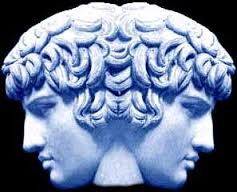Janus was the Roman god from whom we derive the name we give to the first month of the year – January. Janus was the god of beginnings and endings and was often found at the entrance of a building or home, in doorways or passages. At the outbreak of war or with the finding of peace, Janus was considered the appropriate god to mark such momentous times. He had a place at birth and death, at comings and goings and would also oversee the buying and selling of things. Janus was the god of transitions. Janus  could do all this of course because he had two faces – one looking to the past and the other to the future.
could do all this of course because he had two faces – one looking to the past and the other to the future.
It strikes me that Janus would be a suitable god for leaders today.
Leaders today find themselves in a perpetual state of leading through transitions and uncertainty. 2017 promises to be yet another year of massive upheaval following the momentous 2016 that has seen some unprecedented (well in recent history at least) shifts in the political, economic and social landscapes. Threat and opportunity seem to call with equal measure or perhaps, depending on your viewpoint and global location, one might call more persuasively than the other.
The ability to lead through change and transition is an essential leadership trait. In short, leadership always has something to do with change. Kotter adds to this basic understanding by suggesting that it is ‘sustainable change’ that is the mark of effective leadership.
There are many suggestions and words written on how best a leader can develop and sustain this capacity for leading through change. Smart leaders intentionally equip themselves with helpful practices from that which has been written. However, I would like to suggest that the simple image of our friend Janus might also serve as a helpful reference point and reminder for those in leadership.
As a futurist I am often asked about the importance of the past. Any credible futurist will readily admit to just how important the past is in looking to the future. Churchill suggested that further one looks back, the further one can see into the future. Paying careful attention to what has gone before and in that, knowing what to keep, discard and rearrange in building adaptive capacity, is an important leadership responsibility. Equally so is the ability to look into the future and then bring into focus that landscape for others in order to better understand and together work out how best to navigate and explore that landscape.
These twin (and paradoxical) viewpoints – looking back and looking forward, need to be held carefully and skilfully by those entrusted with leadership. Janus really epitomises the very core responsibility of leadership – that of a holistic perspective. He serves as a reminder what leaders need to be doing without providing any help as to how to do that and what it is they need to be seeing.
Perhaps working out the how and what is your responsibility. Building the tools to discerningly look back and intelligently look forward is perhaps something that you need to cultivate within the context of your leadership practice? If so, know that this is an important endeavour and any energy and time given to this task will certainly not be time or energy wasted!
A good starting point as to how to tackle such a task / awareness might be to find an accessible picture or replica of Janus and place it in your office. It will serve as a daily reminder to look both backwards and forwards – and it might well be something that provides a great conversational piece for those entering your office.
Go on try it and see what happens!


